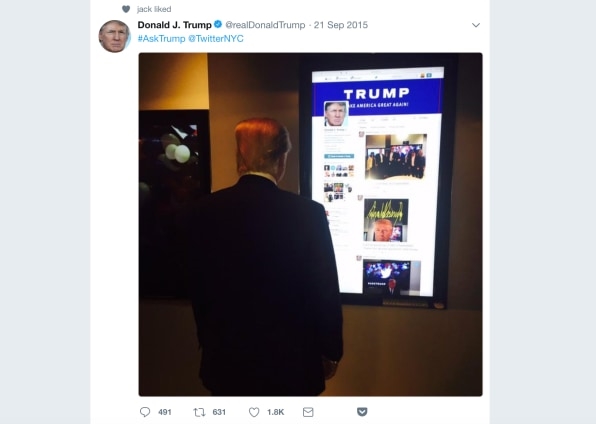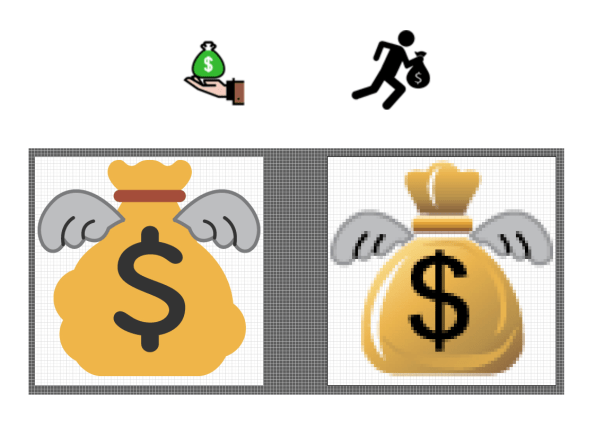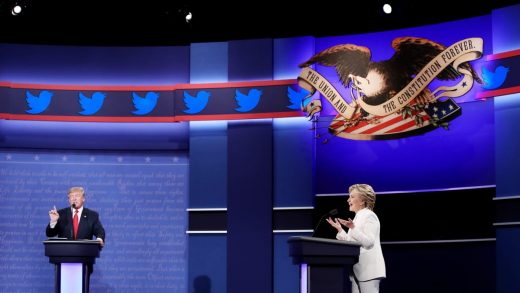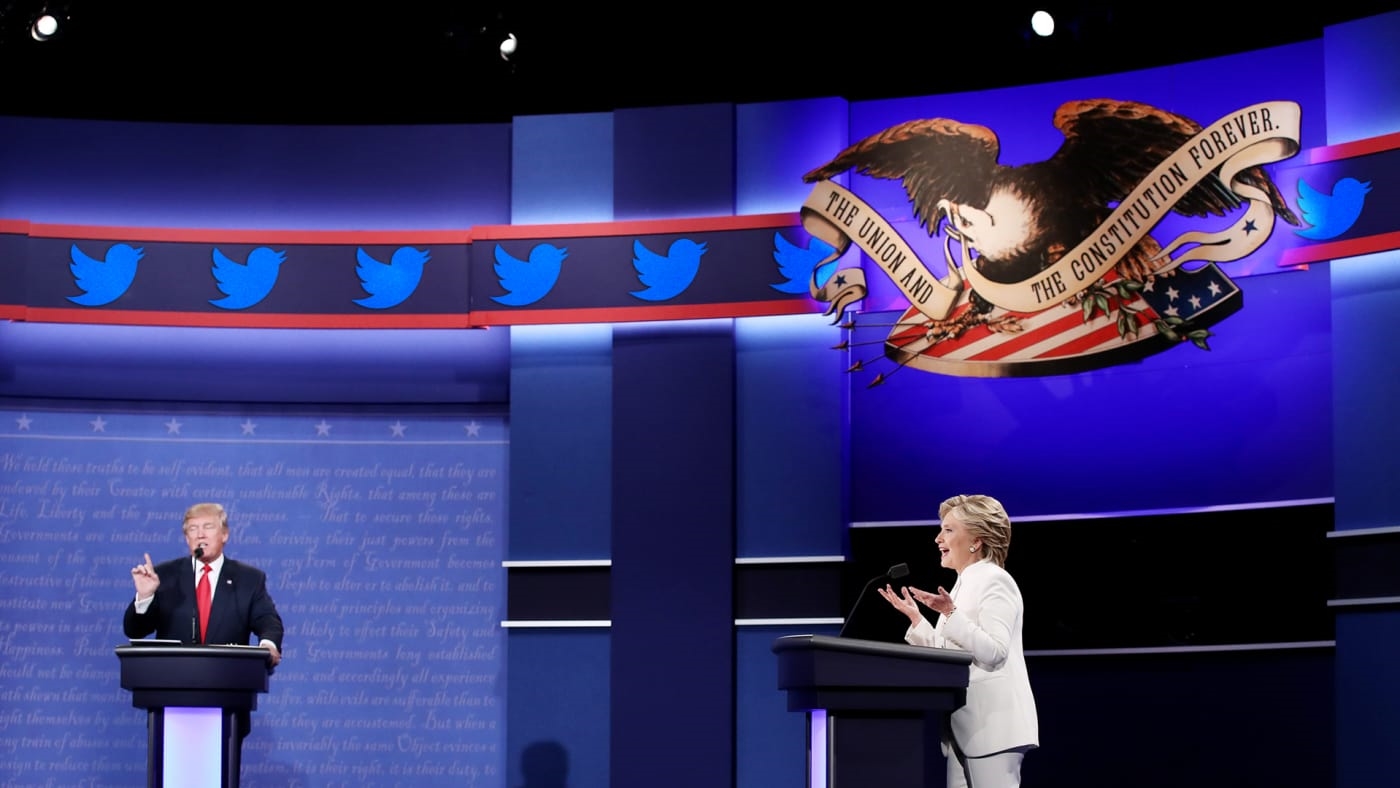Inside The Never-Ending Trump-Clinton Twitter Psychodrama
The morning after U.S. voters elected Donald Trump president, Twitter headquarters looked nearly deserted. Many employees, shocked by his upset over Hillary Clinton, stayed home, apparently too distraught to go to work. Those who ventured into the company’s downtown San Francisco office found an eerie quiet, a visceral pall hanging over the normally buzzy space. “Quite frankly, a lot of us were on the verge of depression,” says an engineer who quit shortly afterward. Recalls a senior employee who also soon left the company, “There were people openly crying at their desks.”
It wasn’t just that Twitter’s predominantly left-leaning workforce was distressed at the political change coming to the White House. Following a year of bitter politicking, mudslinging, and controversies dramatized in viral tweet after viral tweet, employees finally had a chance to reflect on the role their platform played not only in Trump’s rise but the deteriorating national climate: the toxic discourse, the hyper-polarized electorate, the amplification of fringe elements in mainstream media. The effect, some employees say, was dizzying, and in the days that followed, over text messages and email chains and in whispers in the hallway, this feeling of dread, of an unavoidable reckoning, only worsened. “We all had this ‘holy shit’ moment,” says a product team leader at the time, adding that everyone was asking the same question: “Did we create this monster?”
Trump’s victory marked an inflection point for the company. As reported in Fast Company‘s new cover story on Twitter, it would still take months for CEO Jack Dorsey to concede that the company had a responsibility to clean up the social media service, but November 8, 2016, proved to be a pivotal moment in that process, lighting a fuse of internal pressure and outside scrutiny that would eventually force his eyes to open to Twitter’s problems. (Twitter did not respond to a request for comment.)
As the tech companies once again prepare for another big U.S. election year with the 2018 midterms, to shield themselves from digital threats of the future they must study the mistakes of their past. And the uncauterized wounds of 2016 are the first place they’ll have to start. The story of Twitter’s calamitous 2016 election year, told here with previously unreported details, offers a unique lens into how the company was grappling with these issues in real time, missteps and all. It’s not that digital pollution wasn’t pervasive on the platform before the election, but the vicious campaign cycle shed a light on just how consequential this pollution could be, a precursor to the daunting challenges Dorsey and team are still struggling to address today, from the alt-right’s radicalization efforts to automated accounts spewing disinformation to the proliferation of abuse and harassment by increasingly sophisticated trolls.
For some, however, the platform worked beautifully. As Trump said days after his electoral college triumph, tech platforms like Twitter “helped me win.”
Clinton Confusion
As the 2016 election season approached, Twitter was abuzz with excitement. Dorsey had recently returned as CEO, charged with turning around the fortunes of the company, and executives hoped the campaign would be a boon to Twitter. It had been four years prior during the previous U.S. presidential election, when then-President Barack Obama showed the true reach of the platform.
In the first half of the year, Vermont Senator Bernie Sanders leveraged Twitter to amplify his message, and some at Twitter hoped Clinton’s staff would also plow money into the service if she won the Democratic primary against him. Yet in the months that followed her formally securing the nomination in July, the advertising dollars did not flow to Twitter as expected. The Clinton campaign took advantage of her organic reach on Twitter (she had roughly 8 million followers by mid-summer and averaged 27 tweets per day throughout the campaign, more than double Trump’s count), but her digital ad spend was mostly funneled to Facebook and Google, leaving Twitter’s leadership miffed, multiple sources say.
They had links to the social network via their so-called “embeds,” on-the-ground digital operators who essentially assist political teams with advertising distribution. (This arrangement, which has generated some controversy of late, is laughed off by some sources inside both campaigns and at the tech companies, who maintain that it has long been standard practice for the social platforms to have an embed with major ad clients.) But multiple sources familiar with the dynamic at Twitter claim that the company struggled to get Clinton staffers to respond to their emails and phone calls. These sources recall that Twitter’s ad sales team, generally the company’s main contact with the campaigns, made trips to Clinton’s headquarters in Brooklyn to try to meet with officials such as campaign manager Robby Mook, to no avail. “I don’t think one person at Twitter ever even spoke to Robby throughout the entire campaign,” says one source familiar with the situation. “The Clinton campaign was not interested in Twitter’s help.”
The team was so confused by the apparently frail relationship that tittle-tattle started to spread that the reason might be personal. Clinton had visited Twitter headquarters for a company Q&A in 2014, and, however ridiculous it sounded, some wondered whether something might’ve soured her to Twitter then. “There were rumors like, Did the meeting not work out? Did she get stood up? Is there a personal ax to grind?” says another source familiar with the situation. “[Nobody could] could figure out what the hell was going on. Twitter got table scraps [of the digital advertising budget]!”
When told of these assertions, sources inside the Clinton campaign are all but flabbergasted. It was not Mook’s job to interact with ad sales people, for one. But the idea that the Clinton campaign was unreachable? “Horseshit! We couldn’t get ahold of them!” says one source close to the campaign. That they didn’t buy as much of the company’s advertising doesn’t make Twitter some sort of virtual Wisconsin. It was a strategic–not personal–decision: Twitter, with its scale being significantly smaller than Facebook’s and YouTube’s, was simply not the place to reach persuadable voters. “I have never talked to a person in the digital world–either in politics or outside of it–who is not deeply skeptical of Twitter’s advertising offering,” this source continues. “This story that we were difficult to work with? Not true, but frankly, if it were true, we could defend that too [against Twitter].”
He-said-she-said squabbling aside, those in the Clinton orbit have grown increasingly frustrated by this type of narrative, which suggests that Clinton might’ve won if only she listened more to executives at Twitter or Facebook. Tech companies understand how to sell advertising; they don’t understand how to campaign, the thinking goes. Although the Trump campaign chose to follow a different strategy on these platforms, that doesn’t mean it was universally correct because Trump would go on to win the election. Nor does it mean that the strategy Clinton’s staff chose was automatically wrong. For veterans of Hillaryland, it’s not surprising Silicon Valley is trying to veer the public away from criticism regarding how their platforms were manipulated for ill during the election; it’s much more palatable for them to imply that the Clinton campaign merely messed up or didn’t quite grasp the power of their services. (Fitting with this latter narrative, a Facebook white paper concluded that Clinton’s digital advertising wasn’t as “complex” as Trump’s, Bloomberg reported just this week.)
Then there was the issue of safety on Twitter. Throughout 2016, the company was struggling to deal with abuse and harassment on the platform (more on this in a moment), as well as bots and disinformation. Leading into the fall, these problems continued to flare up, even right up to the final days of the campaign when “Pizzagate” took off. The conspiracy theory got its start on Twitter, after an account of a white supremacist promoted the absurdly false claim that evidence was found of a Democratic Party-linked pedophilia ring being run out of the basement of a pizza restaurant. “With Twitter, the challenge is, you just don’t know what’s real,” says a high-level source involved with the Clinton campaign. “It became an extremely hostile place for us, and obviously now we know a little a bit more about why [that happened].” (This hostility wasn’t merely coming from the right: The “Bernie Bros” and even pro-Sanders bots contributed to the toxic atmosphere.)
The source close to the Clinton campaign is adamant that these issues were raised with Twitter and Facebook before the election. “The campaign lodged complaints with all the major tech companies about misinformation problems–it was a constant battle against fringe elements [on the social networks] that believed Hillary was arrested (April 20, 2018). But all of them told us we were barking [up] the wrong tree,” this source says. “It was a total nonstarter in the final stages of the election.”
Sources at Twitter involved with the situation vehemently deny that these issues were ever raised. (For that matter, many of them say “fake news” was thought of internally as a Facebook problem rather than a Twitter problem.) A source familiar with the situation at Facebook acknowledges that the Clinton campaign did contact the company about certain false news items, but stresses that these were anecdotal, one-off inquiries that happened less than a handful of times, rather than related to some larger problem of platform news manipulation. For example, in late October, the Clinton campaign complained about (false) viral posts purporting to show that faulty touch-screen voting machines were stealing votes from Trump.
The Clinton campaign source concedes that they could’ve been more vocal about this problem, but says the campaign was doing its best with the information it had at the time; it’s important not to apply a 2017 filter to 2016 decision-making, and the idea of “fake news” was not as ubiquitous as it is now. “There was not one Farhad Manjoo-type person talking about this stuff!” this source says. “We would’ve gotten laughed at if we’d gone to Twitter every time we saw a viral tweet saying ‘Hillary has multiple sclerosis.’ They would’ve said, ‘Guess what? We don’t influence the content–we’re just a platform.’ It would’ve been a joke.”
“Bullshit Money”
The Trump campaign, meanwhile, arguably had a more fruitful relationship with Twitter. Trump had long made Twitter his social media home, and his short-burst, biting style seemed uniquely suited to the microblogging platform. Like Clinton, he had also visited Twitter’s offices: In September 2015, he went to its New York offices for a live Q&A, which was hosted under the hashtag #AskTrump. As Trump roamed Twitter’s halls, a source present recalls the Republican presidential candidate being less interested in the company’s technology–and more interested in its building’s construction. “He was saying things like, ‘Who did your concrete?’ and ‘I don’t like those fire doors–I know a guy who can give you a better model.’ It was quite funny,” this source laughs.
#AskTrump Getting ready to answer your questions. pic.twitter.com/MiSqyasjhu
— Donald J. Trump (@realDonaldTrump) September 21, 2015
Trump’s team found Twitter an effective platform to use both organically and for advertising. They invested in more direct response marketing and relied on the service as a rapid-response tool to challenge the “mainstream media” and rile up its base. They also better realized the power of the platform beyond its borders: Trump’s tweets were being printed on the front pages of newspapers and splashed across TV screens on CNN and Fox. “We weren’t going to persuade people on Twitter [itself]–I agree with [the Clinton campaign] on that–the targeting wasn’t as sophisticated as Facebook’s and it didn’t have as much scale,” a source close to the Trump campaign says. Still, this source adds, “We thought Twitter offered a good value.”
Since he first joined Twitter, Trump employed snark and vicious attacks to get his message across and had no issue sharing misleading stories or making outlandish claims. Once, for example, he posted that “global warming was created by and for the Chinese in order to make U.S. manufacturing non-competitive,” a tweet that has since been shared or liked nearly 200,000 times. (A recent study published in Science found falsehoods are 70% more likely to be spread on Twitter than truths, and at a substantially faster rate.)
Trump’s Twitter presence stoked anger in more than just his fan base–it also began aggravating the people who worked for Twitter. When the company landed ad deals from the Republican nominee, some employees complained that Twitter should stop accepting Trump’s “bullshit money” or “blood money,” according to several sources.
There was also a noticeable influx of abuse and harassment on the platform (what the high-level Clinton campaign source had called “extremely hostile” content). Twitter’s support agents, who review flagged content, were early in witnessing this trend. “When he threw his hat in the ring and started all the #MAGA rhetoric, that’s when you really started to see these groups [like the alt-right] come up,” says one agent at the time. “We saw this radical shift.”
The trolling efforts seemed robust and organized. “We’d find these subreddits and forums on sites like the Daily Stormer where the alt-right was coordinating [the use of] bots, hashtags, and Russian email domains that didn’t require confirmations and made creating new fake accounts [fast],” says a person familiar with the matter at Twitter. “The sheer number of neo-Nazis, the techniques they were using, Twitter wasn’t prepared.” Adds another user support agent, “You’d remove [their content] and it’d come back within minutes, supporting Nazis, hating Jews, [memes featuring] ovens, and oh, the frog . . . the green frog!”

By the summer, after Trump swept the primaries and secured the nomination, Twitter was working hard to sell both the Clinton and Trump campaigns on a big up-front advertising deal, which involved a $5 million commitment and discounts on ad products such as promoted trends. The Trump team signed the deal in August, part of an all-out, cross-platform assault to generate attention. “Our mind-set wasn’t really on getting max ROI–it was about getting max scale,” says the source close to the Trump campaign.
The deal quickly proved fraught for Twitter, due to a custom hashtag emoji included in the agreement. Because the Clinton campaign didn’t buy the same deal–and because the Trump campaign hoped to attach a scandal-suggestive emoji of a hand-held moneybag to the hashtag #CrookedHillary–some in Twitter’s leadership felt it could lead to legal issues or cries of platform bias. (Ironically, according to a former manager aware of the dynamic, the company had originally considered offering the custom emoji for free to campaigns, but Twitter’s leadership decided it would be too much leverage to sacrifice as they were trying to sell the presidential campaigns on the up-front deal.) The controversy has been litigated in the media since, but the crux of the ordeal is that Twitter approved the Trump campaign’s emoji, until Dorsey unapproved it. The company had the Trump campaign redo the emoji with a less suggestive image–this time, a moneybag with wings instead of a hand holding it–which they had hoped to use during the presidential debates in September and October, but Dorsey ultimately decided to kill that part of the deal outright. “There was vicious [internal] debate and back-channeling to Jack,” says a source involved. “Jack was conflicted. At the eleventh hour, he pulled the plug.”

The Trump campaign was furious, viewing it as–what else?–a form of political bias. (Twitter’s political ad sales team was also angry with Dorsey; several sources suggest they almost quit as a result of his big-footing, which threatened to damage their relationships with clients.) Trump allies managed to get Dorsey on the phone for a conference call, on which, according to multiple sources aware of what was discussed, Dorsey began by praising the campaign’s use of the platform before falling back on a boilerplate defense of the company’s decision. RNC communications director Sean Spicer, who fielded the call en route to a flight at Reagan National Airport, was incensed. When he pressed Dorsey regarding whether personal bias played into the outcome, Dorsey demurred and suggested it was actually the result of a legal review, which Spicer apparently didn’t buy. Several sources recall Spicer, who had by then boarded his plane, fuming on the phone that Twitter couldn’t possibly think they’d get away with this “bullshit” excuse. “When I get off this plane [after it lands], I’m going straight to [the media] and I’m going to fucking kill you guys on this,” he is said to have seethed.
But nearly immediately after the call, the Access Hollywood tape leaked, on October 7, 2016, just before the second presidential debate. Suddenly Trump had bigger problems than Dorsey, though the campaign would soon cancel some of the campaign’s spending on promoted trends and other forms of advertising on Twitter as a punishment. “While I don’t think the concept of a custom emoji was going to dramatically shift support in any direction, to me, it really exposed this anti-Republican bias among Twitter’s leadership,” Spicer tells Fast Company when asked about the debacle. “Not only did it turn out to be bad politics–it was also just bad business.”
Beyond some efforts Twitter made to introduce more safety measures following an abuse incident unrelated to the election, the rest of the campaign season was treated as business as usual. For the most part, many Twitter employees at the time say they weren’t aware that anything was too awry. Certainly the discourse was polarized, but that wasn’t any different from what they were seeing play out on cable news or in highly charged op-eds. Russian election interference was not yet in the zeitgeist, nor was Robert Mueller a household name. Even as more questionable uses of the platform popped up as November neared, Twitter’s leadership largely decided not to insert the company into the political drama. Explains the former manager aware of the dynamic, “In politics, a lot of nefarious efforts, whether bots or abuse or what have you, are asymmetric,” meaning driven by supporters of a particular party or candidate. “The concern was, does fixing the problem look [like we’re] taking sides in an election?”
Dorsey’s Mea Culpa?
In the months following Trump’s win, sources say Dorsey largely stayed silent on the matter internally. When the subject of the election came up in email chains or at weekly “Tea Time” all-hands, he mostly skirted responding. “There were employees asking these really poignant questions about whether he feels accountable. I don’t feel like those questions were answered,” one of these sources says. A close confidante of Dorsey’s even indicates he hasn’t broached the topic with some friends. “I have to tell you, as crazy as this might sound, we haven’t talked about it,” this person says.
Part of the reason, his allies suggest, is likely that there is no good answer for Dorsey to share on what happened in the 2016 presidential election. Given the high profile of Dorsey and his lieutenants, it’s too fraught to weigh in on such a politically charged issue. “There is no way that they can talk about it publicly! Can you imagine?” says a former executive still close to the leadership team, suggesting Twitter’s workforce will never get the Trump apology some employees may be hoping for.
As we report in our cover story, though, Dorsey has come around to recognizing the need both to clean up Twitter’s toxicity and better prepare for a political climate that is only likely to worsen in the years ahead. Following Trump’s controversial immigration ban and continued alt-right manipulation of the platform, Dorsey has become more aggressive in policing the service and investing more resources into product safety.
But the company is still figuring out how to deal with President Trump, who has used Twitter for everything from cyberbullying rivals to undermining the free press to threatening nuclear war against North Korea. “People think Twitter has meetings about whether to take down this or that Trump tweet, as if all the safety brains come together in one room for a discussion,” says a source familiar with the Twitter’s safety operations. “That just doesn’t happen at Twitter.”
Looking ahead to the 2018 midterms as well as the 2020 presidential election, company observers say Dorsey must get a better handle on platform radicalization, disinformation, bots, and other digital threats. But more significantly, Twitter must decide how much it wants to inject itself into the political process: Is political expression and open debate Twitter’s calling, or is it merely a potentially big business?
(69)



